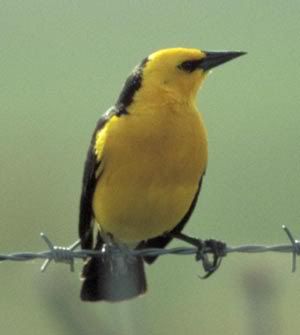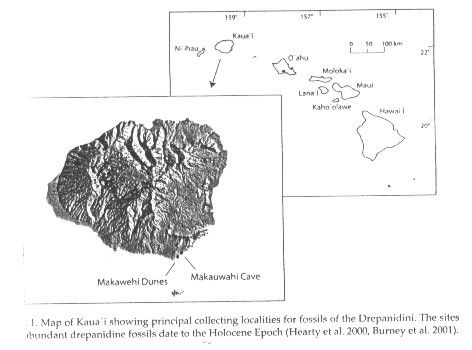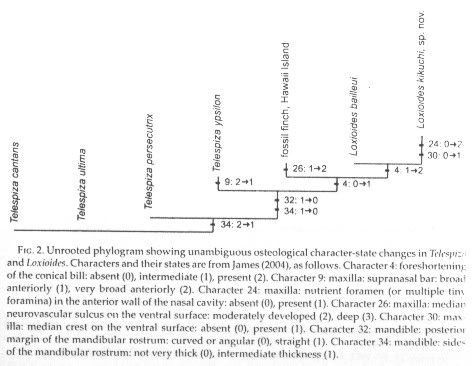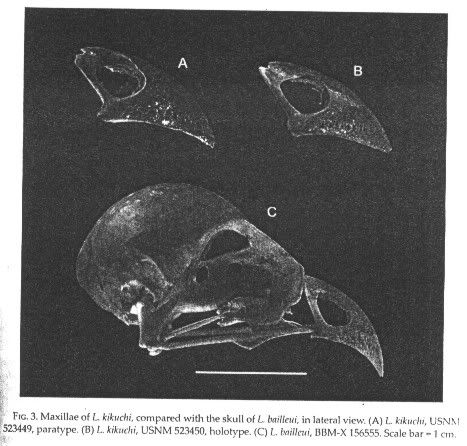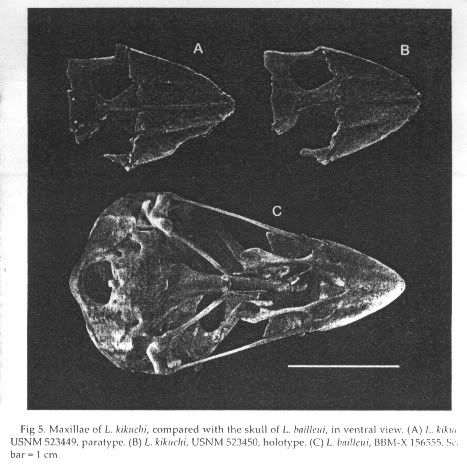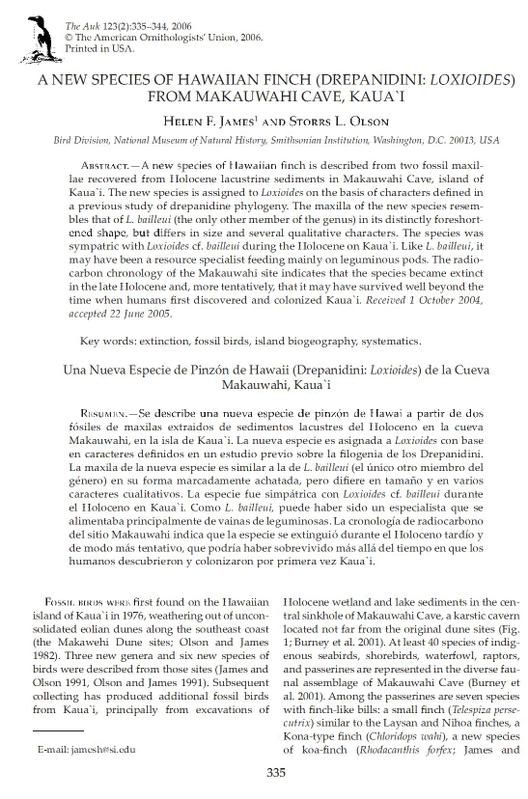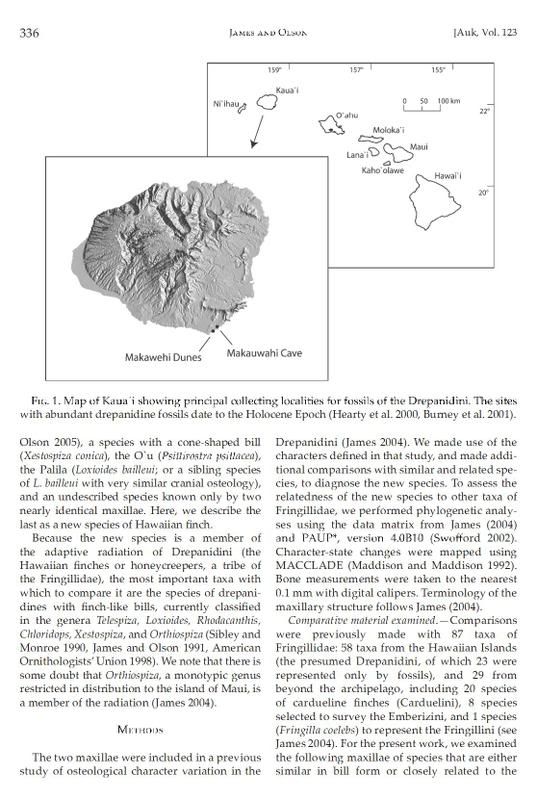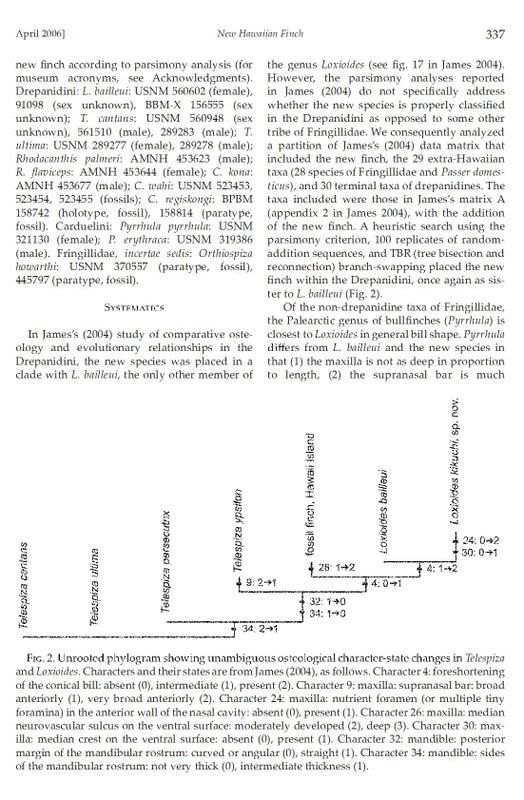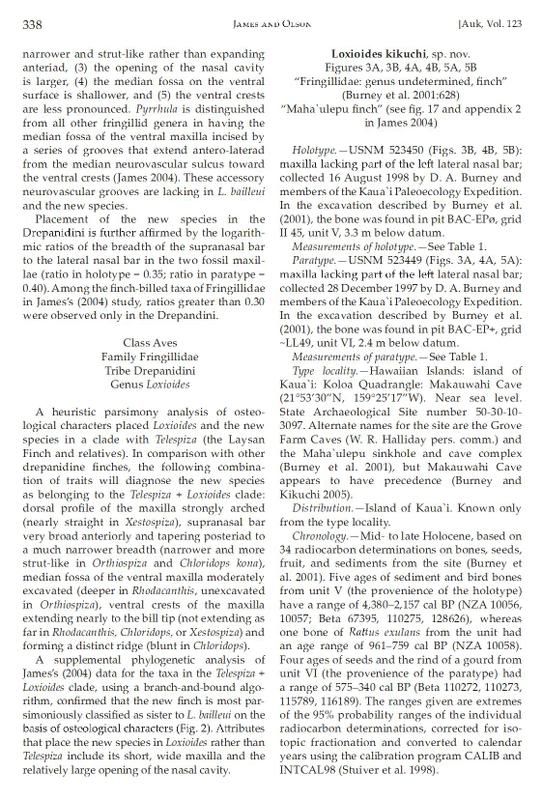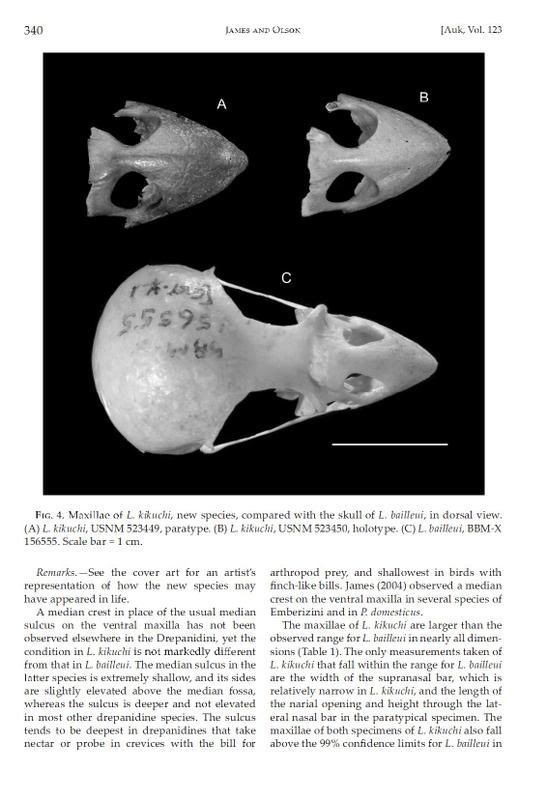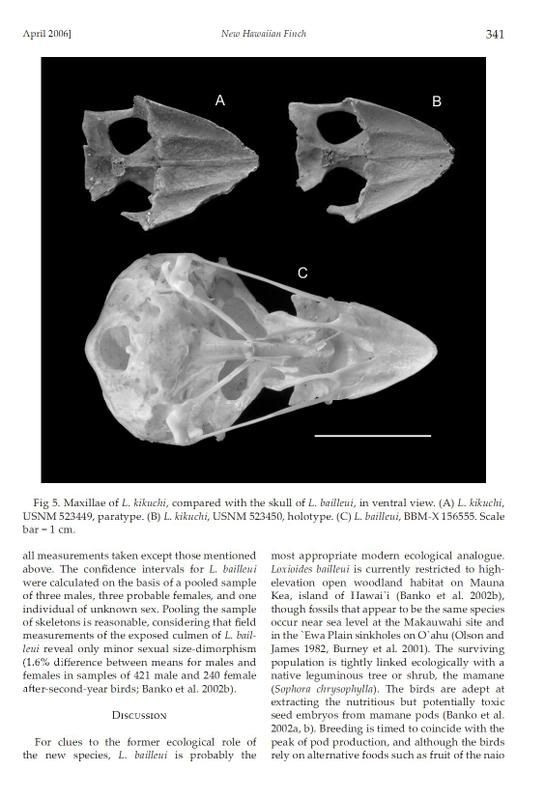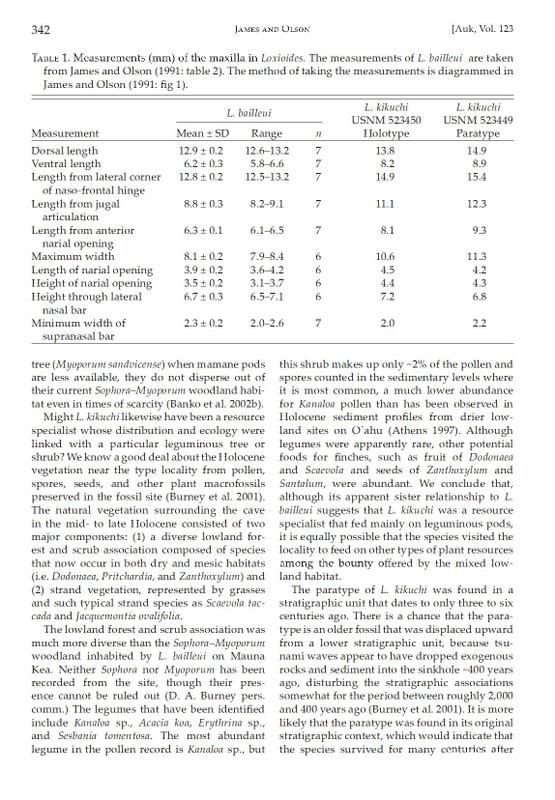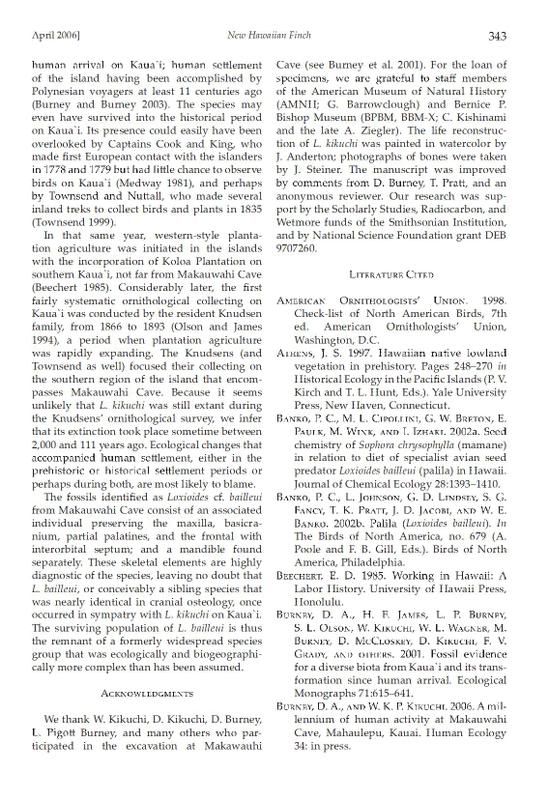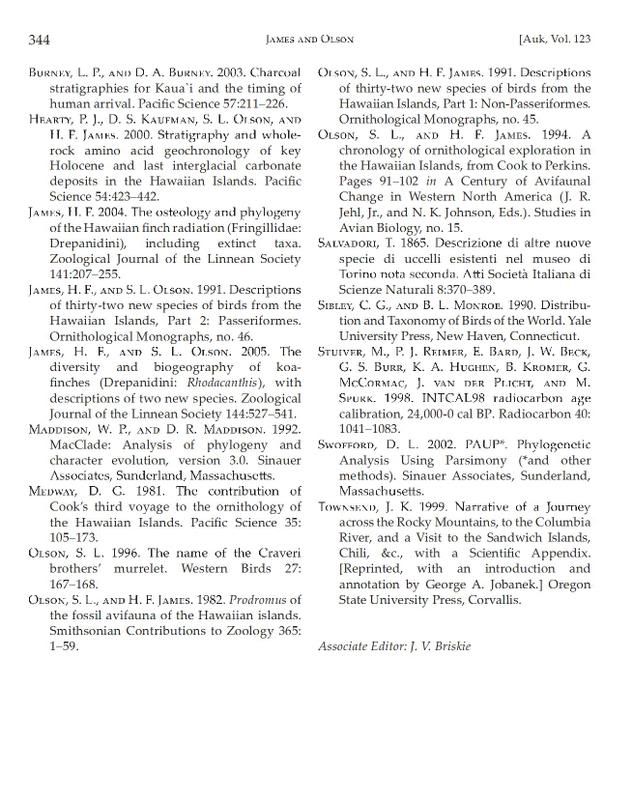Post by dysmorodrepanis on May 31, 2006 21:23:09 GMT
A New Species of Hawaiian Finch (Drepanidini: Loxioides) From Makauwahi Cave, Kaua'I
Auk, The; 4/1/2006
ABSTRACT.-
A new species of Hawaiian finch is described from two fossil maxillae recovered from Holocene lacustrine sediments in Makauwahi Cave, island of Kaua'i. The new species is assigned to Loxioides on the basis of characters defined in a previous study of drepanidine phylogeny. The maxilla of the new species resembles that of L. bailleui (the only other member of the genus) in its distinctly foreshortened shape, but differs in size and several qualitative characters. The species was sympatric with Loxioidcs cf. bailleui during the Holocene on Kaua'i. Like L. bailleui, it may have been a resource specialist feeding mainly on leguminous pods. The radiocarbon chronology of the Makauwahi site indicates that the species became extinct in the late Holocene and, more tentatively, that it may have survived well beyond the time when humans first discovered and colonized Kaua'i. Received 1 October 2004, accepted 22 June 2005.
Key words: extinction, fossil birds, island biogeography, systematics.
Una Nueva Especie de Pinzn de Hawaii (Drepanidini: Loxioides) de la Cueva Makauwahi, Kaua'i
RESUMEN.-Se describe una nueva especie de pinzn de Hawai a partir de dos fsiles de maxilas extraidos de sedimentos lacustres del Holoceno en la cueva Makauwahi, en la isla de Kaua'i. La nueva especie es asignada a Loxioides con base en caracteres definidos en un estudio previo sobre la filogenia de los Drepanidini. La maxila de la nueva especie es similar a la de L. bailleui (el nico otro miembro del gnero) en su forma marcadamente achatada, pero difiere en tamao y en varios caracteres cualitativos. La especie fue simptrica con Loxioides cf. bailleui durante cl Holoceno en Kaua'i. Como L. bailleui, puede haber sido un especialista que se alimentaba principalmente de vainas de leguminosas. La cronologa de radiocarbono del sitio Makauwahi indica que la especie se extingui durante el Holoceno tardo y de modo ms tentativo, que podra haber sobrevivido ms all del tiempo en que los humanos descubrieron y colonizaron por primera vez Kaua'i.
FOSSIL BIRDS WERE first found on the Hawaiian island of Kaua'i in 1976, weathering out of unconsolidated eolian dunes along the southeast coast (the Makawehi Dune sites; Olson and James 1982). Three new genera and six new species of birds were described from those sites (James and Olson 1991, Olson and James 1991). Subsequent collecting has produced additional fossil birds from Kaua'i, principally from excavations of Holocene wetland and lake sediments in the central sinkhole of Makauwahi Cave, a karstic cavern located not far from the original dune sites (Fig. 1; Burney et al. 2001). At least 40 species of indigenous seabirds, shorebirds, waterfowl, raptors, and passerines are represented in the diverse faunal assemblage of Makauwahi Cave (Burney et al. 2001). Among the passerines are seven species with finch-like bills: a small finch (Telespiza persecutrix) similar to the Laysan and Nihoa finches, a Kona-type finch (Chloridops wahi), a new species of koa-finch (Rhodacanthis forfex; James and Olson 2005), a species with a cone- shaped bill (Xestospiza conica), the O'u (Psittirostra psittacea), the Palila (Loxioides bailleui; or a sibling species of L. bailleui with very similar cranial osteology), and an undescribed species known only by two nearly identical maxillae. Here, we describe the last as a new species of Hawaiian finch.
FIG. 1. Map of Kaua'i showing principal collecting localities for fossils of the Drepanidini. The sites with abundant drepanidine fossils date to the Holocene Epoch (Hearty et al. 2000, Burney et al. 2001).
Because the new species is a member of the adaptive radiation of Drepanidini (the Hawaiian finches or honeycreepers, a tribe of the Fringillidae), the most important taxa with which to compare it are the species of drepanidines with finch-like bills, currently classified in the genera Telespiza, Loxioides, Rhodacanthis, Chloridops, Xestospiza, and Orthiospiza (Sibley and Monroe 1990, James and Olson 1991, American Ornithologists' Union 1998). We note that there is some doubt that Orthiospiza, a monotypic genus restricted in distribution to the island of Maui, is a member of the radiation (James 2004).
METHODS
The two maxillae were included in a previous study of osteological character variation in the Drepanidini (James 2004). We made use of the characters defined in that study, and made additional comparisons with similar and related species, to diagnose the new species. To assess the relatedness of the new species to other taxa of Fringillidae, we performed phylogenetic analyses using the data matrix from James (2004) and PAUP*, version 4.0B10 (Swofford 2002). Character-state changes were mapped using MACCLADE (Maddison and Maddison 1992). Bone measurements were taken to the nearest 0.1 mm with digital calipers. Terminology of the maxillary structure follows James (2004).
Comparative material examined. - Comparisons were previously made with 87 taxa of Fringillidae: 58 taxa from the Hawaiian Islands (the presumed Drepanidini, of which 23 were represented only by fossils), and 29 from beyond the archipelago, including 20 species of cardueline finches (Carduelini), 8 species selected to survey the Emberizini, and 1 species (Fringilla coelebs) to represent the Fringillini (see James 2004). For the present work, we examined the following maxillae of species that are either similar in bill form or closely related to the new finch according to parsimony analysis (for museum acronyms, see Acknowledgments). Drepanidini: L. bailleur. USNM 560602 (female), 91098 (sex unknown), BBM-X 156555 (sex unknown); T. cantans: USNM 560948 (sex unknown), 561510 (male), 289283 (male); T. ultima: USNM 289277 (female), 289278 (male); Rhodacanthis palmeri: AMNH 453623 (male); R. flaviceps: AMNH 453644 (female); C. kona: AMNH 453677 (male); C. wahi: USNM 523453, 523454, 523455 (fossils); C. regiskongi: BPBM 158742 (holotype, fossil), 158814 (paratype, fossil). Carduelini: Pyrrhula pyrrhuln: USNM 321130 (female); P. erythraca: USNM 319386 (male). Fringillidae, incertae sedis: Orthiospiza howarthi: USNM 370557 (paratype, fossil), 445797 (paratype, fossil).
SYSTEMATICS
In James's (2004) study of comparative osteology and evolutionary relationships in the Drepanidini, the new species was placed in a clade with L. bailleui, the only other member of the genus Loxioides (see fig. 17 in James 2004). However, the parsimony analyses reported in James (2004) do not specifically address whether the new species is properly classified in the Drepanidini as opposed to some other tribe of Fringillidae. We consequently analyzed a partition of James's (2004) data matrix that included the new finch, the 29 extra- Hawaiian taxa (28 species of Fringillidae and Passer domesticus), and 30 terminal taxa of drepanidines. The taxa included were those in James's matrix A (appendix 2 in James 2004), with the addition of the new finch. A heuristic search using the parsimony criterion, 100 replicates of randomaddition sequences, and TBR (tree bisection and reconnection) branch-swapping placed the new finch within the Drepanidini, once again as sister to L. baillcui (Fig. 2).
FIG. 2. Unrooted phylogram showing unambiguous osteological character-state changes in Telespiza and Loxioides. Characters and their states are from James (2004), as follows. Character 4: foreshortening of the conical bill: absent (0), intermediate (1), present (2). Character 9: maxilla: supranasal bar: broad anteriorly (1), very broad anteriorly (2). Character 24: maxilla: nutrient foramen (or multiple tiny foramina) in the anterior wall of the nasal cavity: absent (0), present (1). Character 26: maxilla: median neurovascular sulcus on the ventral surface: moderately developed (2), deep (3). Character 30: maxilla: median crest on the ventral surface: absent (0), present (1). Character 32: mandible: posterior margin of the mandibular rostrum: curved or angular (0), straight (1). Character 34: mandible: sides of the mandibular rostrum: not very thick (0), intermediate thickness (1).
Auk, The; 4/1/2006
ABSTRACT.-
A new species of Hawaiian finch is described from two fossil maxillae recovered from Holocene lacustrine sediments in Makauwahi Cave, island of Kaua'i. The new species is assigned to Loxioides on the basis of characters defined in a previous study of drepanidine phylogeny. The maxilla of the new species resembles that of L. bailleui (the only other member of the genus) in its distinctly foreshortened shape, but differs in size and several qualitative characters. The species was sympatric with Loxioidcs cf. bailleui during the Holocene on Kaua'i. Like L. bailleui, it may have been a resource specialist feeding mainly on leguminous pods. The radiocarbon chronology of the Makauwahi site indicates that the species became extinct in the late Holocene and, more tentatively, that it may have survived well beyond the time when humans first discovered and colonized Kaua'i. Received 1 October 2004, accepted 22 June 2005.
Key words: extinction, fossil birds, island biogeography, systematics.
Una Nueva Especie de Pinzn de Hawaii (Drepanidini: Loxioides) de la Cueva Makauwahi, Kaua'i
RESUMEN.-Se describe una nueva especie de pinzn de Hawai a partir de dos fsiles de maxilas extraidos de sedimentos lacustres del Holoceno en la cueva Makauwahi, en la isla de Kaua'i. La nueva especie es asignada a Loxioides con base en caracteres definidos en un estudio previo sobre la filogenia de los Drepanidini. La maxila de la nueva especie es similar a la de L. bailleui (el nico otro miembro del gnero) en su forma marcadamente achatada, pero difiere en tamao y en varios caracteres cualitativos. La especie fue simptrica con Loxioides cf. bailleui durante cl Holoceno en Kaua'i. Como L. bailleui, puede haber sido un especialista que se alimentaba principalmente de vainas de leguminosas. La cronologa de radiocarbono del sitio Makauwahi indica que la especie se extingui durante el Holoceno tardo y de modo ms tentativo, que podra haber sobrevivido ms all del tiempo en que los humanos descubrieron y colonizaron por primera vez Kaua'i.
FOSSIL BIRDS WERE first found on the Hawaiian island of Kaua'i in 1976, weathering out of unconsolidated eolian dunes along the southeast coast (the Makawehi Dune sites; Olson and James 1982). Three new genera and six new species of birds were described from those sites (James and Olson 1991, Olson and James 1991). Subsequent collecting has produced additional fossil birds from Kaua'i, principally from excavations of Holocene wetland and lake sediments in the central sinkhole of Makauwahi Cave, a karstic cavern located not far from the original dune sites (Fig. 1; Burney et al. 2001). At least 40 species of indigenous seabirds, shorebirds, waterfowl, raptors, and passerines are represented in the diverse faunal assemblage of Makauwahi Cave (Burney et al. 2001). Among the passerines are seven species with finch-like bills: a small finch (Telespiza persecutrix) similar to the Laysan and Nihoa finches, a Kona-type finch (Chloridops wahi), a new species of koa-finch (Rhodacanthis forfex; James and Olson 2005), a species with a cone- shaped bill (Xestospiza conica), the O'u (Psittirostra psittacea), the Palila (Loxioides bailleui; or a sibling species of L. bailleui with very similar cranial osteology), and an undescribed species known only by two nearly identical maxillae. Here, we describe the last as a new species of Hawaiian finch.
FIG. 1. Map of Kaua'i showing principal collecting localities for fossils of the Drepanidini. The sites with abundant drepanidine fossils date to the Holocene Epoch (Hearty et al. 2000, Burney et al. 2001).
Because the new species is a member of the adaptive radiation of Drepanidini (the Hawaiian finches or honeycreepers, a tribe of the Fringillidae), the most important taxa with which to compare it are the species of drepanidines with finch-like bills, currently classified in the genera Telespiza, Loxioides, Rhodacanthis, Chloridops, Xestospiza, and Orthiospiza (Sibley and Monroe 1990, James and Olson 1991, American Ornithologists' Union 1998). We note that there is some doubt that Orthiospiza, a monotypic genus restricted in distribution to the island of Maui, is a member of the radiation (James 2004).
METHODS
The two maxillae were included in a previous study of osteological character variation in the Drepanidini (James 2004). We made use of the characters defined in that study, and made additional comparisons with similar and related species, to diagnose the new species. To assess the relatedness of the new species to other taxa of Fringillidae, we performed phylogenetic analyses using the data matrix from James (2004) and PAUP*, version 4.0B10 (Swofford 2002). Character-state changes were mapped using MACCLADE (Maddison and Maddison 1992). Bone measurements were taken to the nearest 0.1 mm with digital calipers. Terminology of the maxillary structure follows James (2004).
Comparative material examined. - Comparisons were previously made with 87 taxa of Fringillidae: 58 taxa from the Hawaiian Islands (the presumed Drepanidini, of which 23 were represented only by fossils), and 29 from beyond the archipelago, including 20 species of cardueline finches (Carduelini), 8 species selected to survey the Emberizini, and 1 species (Fringilla coelebs) to represent the Fringillini (see James 2004). For the present work, we examined the following maxillae of species that are either similar in bill form or closely related to the new finch according to parsimony analysis (for museum acronyms, see Acknowledgments). Drepanidini: L. bailleur. USNM 560602 (female), 91098 (sex unknown), BBM-X 156555 (sex unknown); T. cantans: USNM 560948 (sex unknown), 561510 (male), 289283 (male); T. ultima: USNM 289277 (female), 289278 (male); Rhodacanthis palmeri: AMNH 453623 (male); R. flaviceps: AMNH 453644 (female); C. kona: AMNH 453677 (male); C. wahi: USNM 523453, 523454, 523455 (fossils); C. regiskongi: BPBM 158742 (holotype, fossil), 158814 (paratype, fossil). Carduelini: Pyrrhula pyrrhuln: USNM 321130 (female); P. erythraca: USNM 319386 (male). Fringillidae, incertae sedis: Orthiospiza howarthi: USNM 370557 (paratype, fossil), 445797 (paratype, fossil).
SYSTEMATICS
In James's (2004) study of comparative osteology and evolutionary relationships in the Drepanidini, the new species was placed in a clade with L. bailleui, the only other member of the genus Loxioides (see fig. 17 in James 2004). However, the parsimony analyses reported in James (2004) do not specifically address whether the new species is properly classified in the Drepanidini as opposed to some other tribe of Fringillidae. We consequently analyzed a partition of James's (2004) data matrix that included the new finch, the 29 extra- Hawaiian taxa (28 species of Fringillidae and Passer domesticus), and 30 terminal taxa of drepanidines. The taxa included were those in James's matrix A (appendix 2 in James 2004), with the addition of the new finch. A heuristic search using the parsimony criterion, 100 replicates of randomaddition sequences, and TBR (tree bisection and reconnection) branch-swapping placed the new finch within the Drepanidini, once again as sister to L. baillcui (Fig. 2).
FIG. 2. Unrooted phylogram showing unambiguous osteological character-state changes in Telespiza and Loxioides. Characters and their states are from James (2004), as follows. Character 4: foreshortening of the conical bill: absent (0), intermediate (1), present (2). Character 9: maxilla: supranasal bar: broad anteriorly (1), very broad anteriorly (2). Character 24: maxilla: nutrient foramen (or multiple tiny foramina) in the anterior wall of the nasal cavity: absent (0), present (1). Character 26: maxilla: median neurovascular sulcus on the ventral surface: moderately developed (2), deep (3). Character 30: maxilla: median crest on the ventral surface: absent (0), present (1). Character 32: mandible: posterior margin of the mandibular rostrum: curved or angular (0), straight (1). Character 34: mandible: sides of the mandibular rostrum: not very thick (0), intermediate thickness (1).



